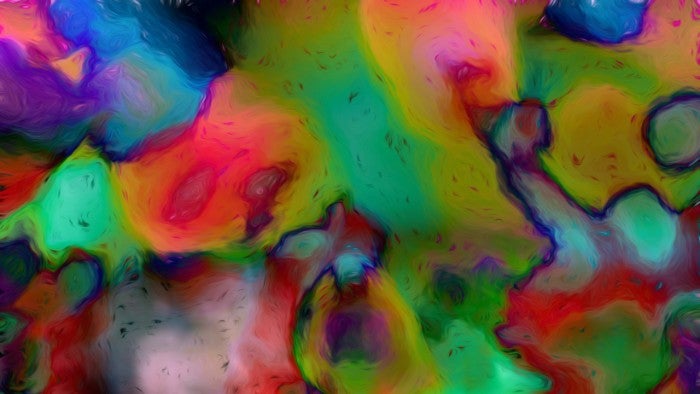

Medically reviewed by Giordano Novak, University of São Paulo on April 3rd 2022
An LSD trip can be a life-changing experience, and it has often been compared to shrooms in its ability to inspire spiritual awakenings in people.
A powerful hallucinogenic drug, LSD, can lead to fantastic experiences (although it is not without the risk of a bad trip).
LSD hallucinations can be intense, so it’s important to always take it when you have a sober person with you.
That way, they can help calm you down if you have a bad trip and will be able to look after you if you don’t get the experience you wanted.
In this guide, we take you through what you can expect from an acid trip after drug use and everything you need to know about how the hallucinogenic effects of LSD work.
LSD is a semi-synthetic psychedelic drug that is derived from ergot alkaloids found in rye fungus. It is often referred to as ‘ACID’ due to the chemical name of LSD, Lysergic Acid Diethylamide.
It is considered a hallucinogen, and its effects can be EXTREMELY powerful, lasting up to 12 hours or longer.
When LSD is taken, it is usually in the form of a small, square pill or on blotter paper (a sheet of paper that is impregnated with liquid LSD).
The effects of LSD can range from intense colours, shapes and sounds to feelings of euphoria, insight into one’s life, SPIRITUAL awakenings, and even terrifying hallucinations (a bad trip).

Yes, LSD is a hallucinogen. It is classified as a psychedelic drug and is often used by people looking to EXPLORE altered states of consciousness or to have spiritual experiences.
When taken, LSD can cause the user to see things that are not really there, such as vivid colours, shapes, or sounds. They may also experience an ALTERED sense of time, an intensified sense of emotion, and a distortion of their senses.
The LSD experience is highly unpredictable and can range from pleasurable to intensely frightening. It is important to ALWAYS take it with someone you trust who is sober so that they can look after you if needed.
Hell yeah! It is possible for LSD users to have recurring hallucinations. These can be triggered by certain stimuli, such as music, lights, and even conversation.
Hallucinations caused by LSD tend to wear off eventually, but it is important to remember that the effects of LSD can last a long time—up to 12 hours or more) according to the National Institute of Drug Abuse [1]. (BOOK A WHOLE DAY OFF IF YOU’RE DOING LSD)
It is also possible to have flashbacks, which is when the user experiences a sudden return of the hallucinations caused by the Illicit drugs (LSD).
On an LSD trip, you might experience intense visual hallucinations. These can take MANY forms, including geometric shapes and patterns, cartoon-like images, distorted faces or objects, trails of light, and vivid colours [2].
You may also see complete scenes in front of your eyes that DON’T actually exist. These could be anything from jungles and cityscapes to vivid abstract art.
Pro Tip: It is important to remember that LSD is a powerful hallucinogen, so always make sure you are with someone who is sober and can help guide you through any challenging moments.
A bad trip is when a person has a negative experience while on LSD. This can include intense feelings of fear, paranoia, anxiety, and even terror. The user may also see HORRIFYING images or feel like they are going CRAZY.
If you find yourself in this situation, it is important to remember that the effects of LSD will eventually wear off, and the experience is NOT real. Try to stay calm and focus on something that is comforting, such as music or a peaceful environment.
People who are more prone to a bad trip include those with a HISTORY of mental health issues and those who take LSD in large doses. It is always important to take LSD under the supervision of someone you trust [4].
Pro Tip: If you feel like you need additional support, contact your doctor or mental health provider immediately.
Having a positive LSD high is all about setting your intention before you take the drug. Make sure you are in an environment that is COMFORTABLE and free from distractions, as this can help reduce the risk of having a bad trip.
It is also important to PREPARE yourself for the experience by learning everything you can about LSD and what to expect and by creating a plan of action in case you have a bad trip.
Finally, make sure to take LSD with someone you trust and who is sober. This is key for ensuring that you can be looked after if needed.
By following these guidelines, you will be able to ensure that your LSD experience is as positive and safe as possible.
The risks and side effects of acid can be SERIOUS if it is used improperly or taken in large doses (although it is unlikely to be fatal). Common side effects include:
It is also possible to experience flashbacks after taking LSD. Long-term use of LSD can lead to a RANGE of mental health issues, including depression and anxiety.
Pro Tip: You should not take acid with alcohol, as this can be an extremely dangerous practice. The same goes for mixing it with other hallucinogens.
It is also possible to develop a tolerance for LSD, meaning that you may need to take higher doses in order to experience the same results [3].
Acid is not classed as an addictive drug, and LSD produces tolerance over time but little else. However, using the drug repeatedly can lead to substance abuse, so you should be careful.
Pro Tip: The lack of drug addiction from LSD means there are no physical withdrawal symptoms recorded.
It’s so important to be safe when you’re buying LSD. When you’re buying from just anyone, you risk a product that isn’t pure and has instead been LACED with chemicals. If you want to buy reputable LSD online, stick with us.
This Canadian seller is reputable, and trustworthy, and only delivers PURE products without risk of contamination. This is why it’s our top recommendation for buying LSD safely.
LSD is a powerful hallucinogen that can cause intense visual hallucinations, altered states of consciousness, and spiritual awakenings. Although it is POSSIBLE to have a positive LSD high with proper preparation, it is important to always take the drug with someone you trust who is sober.
It is also best to buy LSD from a reputable source in order to ENSURE that the product is pure and uncontaminated. With these guidelines in mind, you can make sure your LSD experience is a positive one.
Subscribe and get $15 off your next order!
PRISMS LSD CANADA
Please note we have a new etransfer email. Please follow the details at checkout.
Dismiss